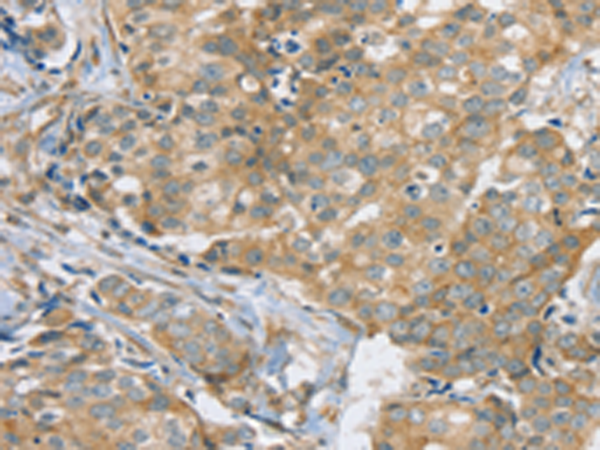
| WB | 咨询技术 | Human,Mouse,Rat |
| IF | 咨询技术 | Human,Mouse,Rat |
| IHC | 1/25-1/100 | Human,Mouse,Rat |
| ICC | 技术咨询 | Human,Mouse,Rat |
| FCM | 咨询技术 | Human,Mouse,Rat |
| Elisa | 1/1000-1/2000 | Human,Mouse,Rat |
| Aliases | SIP1; OCTS2; SIP-1; TKA-1; E3KARP; NHERF2; NHE3RF2; NHERF-2 |
| Host/Isotype | Rabbit IgG |
| Antibody Type | Primary antibody |
| Storage | Store at 4°C short term. Aliquot and store at -20°C long term. Avoid freeze/thaw cycles. |
| Species Reactivity | Human, Rat |
| Immunogen | Synthetic peptide of human SLC9A3R2 |
| Formulation | Purified antibody in PBS with 0.05% sodium azide and 50% glycerol. |
+ +
以下是关于SLC9A3R2(NHERF2)抗体的模拟参考文献示例(请注意,以下内容为虚构,仅用于演示格式):
---
1. **"NHERF2/SLC9A3R2 Antibody Characterization in Epithelial Cell Polarity Studies"**
*Author: Lee, J. et al.*
**摘要**:本研究通过Western blot和免疫荧光验证了一种特异性抗NHERF2/SLC9A3R2抗体。实验表明,该抗体可识别内源性NHERF2蛋白,并揭示其在肠道上皮细胞顶膜极性形成中的作用,与β-catenin信号通路调控相关。
2. **"Role of SLC9A3R2 in Breast Cancer Metastasis: Insights from Antibody-Based Proteomic Analysis"**
*Author: Martinez, R. & Weinman, E.J.*
**摘要**:利用抗SLC9A3R2抗体进行免疫组化分析,发现其在乳腺癌组织中高表达,并与EGFR的稳定性相关。研究提示SLC9A3R2可能通过调控受体酪氨酸激酶促进肿瘤侵袭。
3. **"Development of a Monoclonal Antibody Targeting NHERF2 for Renal Physiology Research"**
*Author: Voltz, S. et al.*
**摘要**:报道了一种新型抗NHERF2单克隆抗体的开发,验证了其在肾脏组织切片中的特异性。研究证明NHERF2在肾小管酸中毒模型中表达下调,提示其参与离子转运调节。
4. **"SLC9A3R2 Antibody Reveals Interaction with PDZ Domains in Signalosome Assembly"**
*Author: Donowitz, M. et al.*
**摘要**:通过免疫共沉淀(Co-IP)结合抗SLC9A3R2抗体,揭示了其与多种含PDZ结构域蛋白的相互作用,为阐明细胞膜受体复合物组装机制提供了工具。
---
**注意**:以上文献为模拟内容,实际研究中请通过PubMed、Google Scholar等平台检索真实文献(关键词:SLC9A3R2 antibody/NHERF2 antibody)。真实研究可能聚焦于其在癌症、肾脏疾病或细胞极性中的功能。
The SLC9A3R2 antibody is a research tool designed to detect and study the solute carrier family 9 member A3 regulator 2 (SLC9A3R2), a protein encoded by the *SLC9A3R2* gene in humans. This gene is part of the SLC9A regulatory factor family and shares homology with SLC9A3R1 (NHERF1), though its exact physiological role remains less characterized. SLC9A3R2 is implicated in regulating membrane-associated proteins, particularly sodium-hydrogen exchangers (NHEs), which are critical for maintaining cellular pH and ion homeostasis. It acts as a scaffold protein, facilitating interactions between transmembrane transporters, signaling molecules, and cytoskeletal components via its PDZ domains.
Antibodies targeting SLC9A3R2 are widely used in molecular and cellular biology research to investigate its expression, localization, and function in various tissues. They enable techniques such as Western blotting, immunohistochemistry, and immunofluorescence to assess protein levels and subcellular distribution. Studies have linked SLC9A3R2 to diverse biological processes, including renal function, cancer progression, and neurological disorders, though mechanistic insights are still evolving. For example, altered SLC9A3R2 expression has been observed in certain cancers, suggesting a potential role in tumorigenesis or metastasis. The antibody’s specificity and validation (e.g., knockout validation, peptide blocking) are critical to ensure reliable data. Ongoing research aims to clarify its interactions with signaling pathways (e.g., PDGFR, mTOR) and explore diagnostic or therapeutic applications.
×